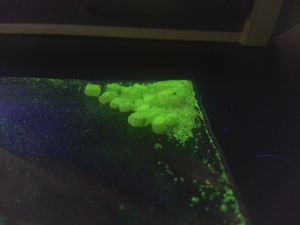Difference between revisions of "Terbium sulfate"
| Line 62: | Line 62: | ||
| MeltingPt_ref = | | MeltingPt_ref = | ||
| MeltingPt_notes = (decomposes)<ref>David R. Lide (Hrsg.): CRC Handbook of Chemistry and Physics. 90. Auflage. (Internet-Version: 2010), CRC Press/Taylor and Francis, Boca Raton, FL, Properties of the Elements and Inorganic Compounds, S. 4-94</ref> | | MeltingPt_notes = (decomposes)<ref>David R. Lide (Hrsg.): CRC Handbook of Chemistry and Physics. 90. Auflage. (Internet-Version: 2010), CRC Press/Taylor and Francis, Boca Raton, FL, Properties of the Elements and Inorganic Compounds, S. 4-94</ref> | ||
| + | | Odor = Odorless | ||
| pKa = | | pKa = | ||
| pKb = | | pKb = | ||
| Solubility = Slightly soluble | | Solubility = Slightly soluble | ||
| − | | SolubleOther = | + | | SolubleOther = Insoluble in hydrocarbons |
| Solvent = | | Solvent = | ||
| − | | VaporPressure = | + | | VaporPressure = ~0 mmHg |
}} | }} | ||
| Section3 = {{Chembox Structure | | Section3 = {{Chembox Structure | ||
| Line 89: | Line 90: | ||
| Section6 = {{Chembox Hazards | | Section6 = {{Chembox Hazards | ||
| AutoignitionPt = | | AutoignitionPt = | ||
| − | | ExploLimits = | + | | ExploLimits = Non-flammable |
| ExternalMSDS = [https://www.docdroid.net/9FLZjxX/terbium-sulfate.pdf.html Sigma-Aldrich] | | ExternalMSDS = [https://www.docdroid.net/9FLZjxX/terbium-sulfate.pdf.html Sigma-Aldrich] | ||
| − | | FlashPt = | + | | FlashPt = Non-flammable |
| LD50 = | | LD50 = | ||
| LC50 = | | LC50 = | ||
| Line 116: | Line 117: | ||
===Physical=== | ===Physical=== | ||
Terbium sulfate appears to crystallize in the hexagonal crystal system. It is a white solid that can be quite powdery when crushed. As a powder, it passes ''very easily'' through filter paper. | Terbium sulfate appears to crystallize in the hexagonal crystal system. It is a white solid that can be quite powdery when crushed. As a powder, it passes ''very easily'' through filter paper. | ||
| − | |||
==Availability== | ==Availability== | ||
| Line 133: | Line 133: | ||
===Storage=== | ===Storage=== | ||
| − | + | Terbium sulfate should be kept in closed plastic or glass bottles, away from moisture and acids. | |
===Disposal=== | ===Disposal=== | ||
Revision as of 19:45, 24 October 2018
 Terbium sulfate fluorescing in a plastic bag
| |
| Names | |
|---|---|
| IUPAC name
Terbium(III) sulfate
| |
| Other names
Diterbium trisulphate
| |
| Properties | |
| Tb2(SO4)3 | |
| Molar mass | 750.16 |
| Appearance | White crystalline solid |
| Odor | Odorless |
| Melting point | 360 °C (680 °F; 633 K) (decomposes)[1] |
| Boiling point | Decomposes |
| Slightly soluble | |
| Solubility | Insoluble in hydrocarbons |
| Vapor pressure | ~0 mmHg |
| Hazards | |
| Safety data sheet | Sigma-Aldrich |
| Flash point | Non-flammable |
| Except where otherwise noted, data are given for materials in their standard state (at 25 °C [77 °F], 100 kPa). | |
| Infobox references | |
Terbium sulfate is an ionic compound with the formula Tb2(SO4)3. It is notable for being extremely fluorescent, emitting bright green light under shortwave ultraviolet light. It is relatively insoluble in water, especially when precipitated with potassium sulfate, forming a double sulfate with the formula KTb(SO4)2.
Contents
Properties
Chemical
Terbium sulfate is generally inert to reduction or oxidation. Heating to approximately 1500 degrees Celsius, however, produces terbium(III,IV) oxide. Its solubility in water decreases with heating, but it has a tendency to supersaturate, and a supersaturated solution of terbium sulfate may not crystallize for days.
Physical
Terbium sulfate appears to crystallize in the hexagonal crystal system. It is a white solid that can be quite powdery when crushed. As a powder, it passes very easily through filter paper.
Availability
Terbium sulfate is extremely difficult to find at a reasonable price, but the materials needed for preparation, terbium metal and sulfuric acid, can be found quite easily.
Preparation
Terbium sulfate can be made by adding terbium metal to sulfuric acid. Terbium sulfate, however, does not dissolve in water easily, so stirring the metal to remove the layers of terbium sulfate powder helps greatly.
Projects
- Make fluorescent crystals
Handling
Safety
Terbium sulfate does not appear to be particularly toxic.
Storage
Terbium sulfate should be kept in closed plastic or glass bottles, away from moisture and acids.
Disposal
Due to the rarity of terbium, it's best to recycle it.
References
- ↑ David R. Lide (Hrsg.): CRC Handbook of Chemistry and Physics. 90. Auflage. (Internet-Version: 2010), CRC Press/Taylor and Francis, Boca Raton, FL, Properties of the Elements and Inorganic Compounds, S. 4-94